History of the Serbian Army
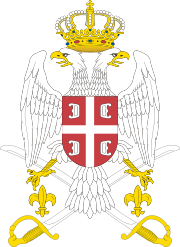 |
| Components |
|---|
| Serbian Air Force and Air Defence |
| Ranks |
| Military ranks of Serbia |
| History |
| Serbian Army Serbian Air Force Military history of Serbia |
| Equipment |
| Air Force and Air Defence |
The history of the Serbian Army dates back to the Serbian Revolution (1804–17).
Habsburg Serb military
Revolutionary Army
During the 18th century, Serbs had fought the Turks as auxiliaries to the Austrian army on both sides of the Turkish border, and had been important in defending the 20-year Austro-Hungarian rule over Belgrade and the northern parts of Serbia. The return of Ottoman rule after the Treaty of Swistowa between Austria and Turkey did not mean the end of Serbs serving under arms as the Sultan needed a serb militia to oppose Janissary corps in Serbia. This ended when the Janissaries got the upper hand and took power under a junta of 4 known as the dahis.
The overthrow of the Dahis was nominally in the name of the Sultan but in fact was the work of an uprising of Serbs led by Karađorđe with only token support from troops sent by the Sultan. That Belgrade had fallen to Serb forces put them in a strong negotiating position with the Sultan and consequently what the Serbs expected in terms of autonomy was more than the Sultan was able to offer
The final break with Istanbul came with the Battle of Ivankovac in which the Serbs were victorious. This was followed by further victories at Misar and Deligrad. Serbian rebel army was small in number but used sconce fortress to battle Turkish number superiority.The rebels not only defeated the Turkish army, but also inadvertently Napoleon himself who equipped and instructed the Turkish army to strike from three sides, and who saw every withdrawal of the Turkish army as the advancement of Russia. Though allies in ideology, Austrians also feared Russian intentions. Russia preferred to see the Balkan peninsula divided and the Serbian uprising as an incentive to the Greek Liberation Movement. Unaware of the rules of top politics, as early as February 1806 Serbs appealed to the Russian Tzar to support their right to the national state in the Balkan provinces where they could rise the army of up to 200,000 men. Though almost illiterate and uneducated in military profession, Serbian leaders recognized the importance of strategic factors, the role of the army and security challenges of those times while making decisions.
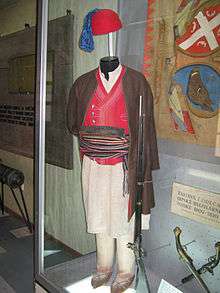
After their refusal to accept the terms of Russian-Turkish Treaty, the Serbian army suffered defeat in 1813. Russia, which was in expectation of another invasion of Napoleon, signed an agreement in Bucharest, which was rather indefinite for the Serbs.
It was up to them now to agree with the Turks on tax rates and the sale of weapons. The Turks were to reestablish the former garrisons. The hajduks (outlaws also freedom fighters) were allowed to flee to Russia and Germany, while Russia designated Austria as the protector of Serbia’s autonomy, the country whose Chancellor supported the Ottoman Empire. At the national assembly in Kragujevac, where the elders refused this offer, it was stressed that “this land belonged to our forefathers and that we have redeemed it with our blood”. If a Russian has promised the Turks fortifications, he will have to deliver them some other fortifications”.
The commitment of soldiers and the commanders till the last moment, their bearing in face of a much more numerous enemy, the Turks would remember well. The very thought of this and the possibility of seeing this again made the Turks yield later on. When the new uprising broke out in 1815, they were more ready to yield.
During the uprisings the Serbian army was of the national character. The leaders of the Serbian army drafted farmers only when a battle was ahead. They provided equipment and weapons themselves. In addition to this mass of fighters drafted on call, during the first Serbian revolutionary statehood there were standing regiments of skilled and armed lads who were paid for their service. They were called becari or lads, and they served as some sort of security for the Duke Kardjordje and other dukes. They protected fortifications and secured borders.
Prince Miloš following the Second Serbian Uprising disbanded the army but it was not disarmed. Though it was not until King Milan cancelled this Swiss system of armed reserve corps, the peasants of Timok Krajina refused to lay down their arms and started an uprising which the standing army would soon suppress.[1]
Russia's influence on military development
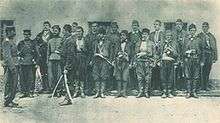
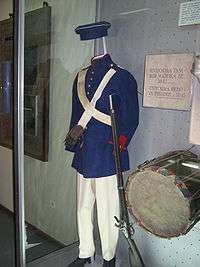
The 19th century was marked by upgrading the system of national but also of the standing army in the autonomous Principality and later Kingdom of Serbia. The army kept abreast of times with the then current European experiences, economical powers. The Serbian effort to organize an adequate standing army will be opposed by Austria and the Ottoman Empire. On the other hand, the already attained autonomy was not certain, and without the armed forces and military organization, the idea of further struggle for independence was inconceivable. With the Yedren Treaty (1827–1829), Russia gained patronage over the Serbian Army, so and thus had its impact on the Serbian Army. A small army after its won army was organized by Russia, active officers were from Russia, Russian laws and exercises were introduced. In the period 1830–1835 an infantry battalion, equine squadron and a gun battery were formed. The first group of 12 youths was sent to Russia to be educated as officers. The first Law on the Establishment of Garrison Army was adopted in 1838. The army fell under the competencies of the Ministry of Interior Affairs. By the end of 1847 the standing army of Serbia barely totaled 2.438 officers, professional military members and soldiers. The infantry was augmented by another battalion consisting of four companies. Austria did not favor Serbia’s growing statehood and its Army’s. In 1860 junior Serbian officers came from the Austro Hungarian Army into Serbian Army. Also other civilians, mostly Slovenians, doctors, engineers, musicians and branch officers, came into Serbian Army. In 1867, Serbia adopted the Law on Accepting Foreign Officers. But it was France that had a predominant influence on the growth of the Serbian Army, while Prussia had less influence following its victory over Napoleon III. As to the military theory it was based on the thoughts of German military writers, who still kept Napoleon’s military thinking alive.[1]
Modernization and reorganization of the army using the French model
It was no longer possible to improvise with infantry and artillery. An idea of a modernized army was promoted by the most distinguished Serbian politicians and soldiers of those times. All these ideas as well as his experience gained in his later education in France and Vienna general Milivoje Blaznavac passed on to Ilija Garašanin as well as the idea of opening the Artillery School ( Military Academy). On the other hand, the vested interests of France in Serbian Army because of the Crimea War led to close cooperation on building a gun factory and on staff education. Then created relations would lead to appointing a Frenchman Hippolyte Monden (1861–1865) Minister of the Army Ministry, who was charged with making a complete study on Serbia. However, it should be noted, that the idea of military professional leading the army followed the death of Prince Miloš as in his exodus of the Karađorđević dynasty he banished the most distinguished modernization promoters, Blaznavac being among them.[1]
Establishment of new ministry

It was Monden who actually established the Army Ministry, and under his competences fell the Ministry of Civil Engineering as bridges, roads, water supply systems and later railway system were a prerequisite in all European countries for mobilization and military operations. Monden’s right hand was Blaznavac. Russian Laws and Regulations were substituted with French or were somewhat tailored to suit Serbian circumstances. Pension funds for officers and NCOs were established, health care service was reorganized, and horse breeding as a prerequisite for raising the army was improved. The Serbian Assembly adopted a Law on National Army. Only the French posit their trust in this army of 100–150,000 soldiers who had reports from Monden as well as experiences in Crimea wars and Garribaldy's operations. The national army, now equipped with numerous artillery weapons, made visible progress thanks to the nation's zeal.[1]
The Serbian officers’ complaints of the Russian command and of armaments, and of the lack in professionally trained active NCOs and active commanding officers, resulted in an increase in the number of cadets in schools, in establishing a wider peace keeping formation. Following an imposed war on Bulgaria in 1885, King Milan became the military commander in chief and initiated the most important reform which set foundations for future liberation wars in the period 1912–1918.[1]
In all periods, it was of paramount importance for the strengthening of the Serbian Army for the ruling dynasty and the most prominent political factors to agree. In the periods marked by the domination of political factors over the army and its needs, it was sometimes difficult to make even the crucial demands pertaining to the army.[1]
A prominent place was held in the tradition of the Serbian Army by the following leaders: Karađorđe, Prince Miloš, Hajduk-Veljko, Tanasko Rajić. The units which bore the names of these champions of Serbian people on their flags never disgraced them.[1]
Organization in the 1900s
At the beginning of the 20th century the Serbian army was reorganized in accordance to newly adopted Law of the organization of the military (Zakon o ustrojstvu vojske) from 1901. According to the law all males between 17 and 50 years were subjects of military service, army was divided into National army composed of men of age between 20 and 45 years, and Last defense troops composed of youths of age between 17 and 20 years and veterans between 45 and 50 years. The National army was further divided into three age classes called poziv (literally call). The troops of I poziv (1st line or class) were composed of men aged 20–37, II poziv of men 31–37 and finally III poziv of men aged 37–45 years. Territorially state was divided into five divisional areas:
Morava divisional area:
- Vranje regimental district
- Prokuplje
- Pirot
Drina
- Užice
- Valjevo
- Šabac
Dunav
- Beograd
- Požarevac
Šumadija
- Čačak
- Kragujevac
- Kruševac
Timok
- Negotin
- knjaževac
- Zaječar
Divisions were named by divisional area and class f.e Drinska divizija I poziva roughly translated as Drina division I class/call, regiments were called by branch, ordinary number, class and sometimes by specific name f.e I pešadijski puk I poziva Miloš Veliki or 1st infantry regiment of I class Miloš Veliki . Consequently, the divisions and regiments were doubled and their names differed only by class they belonged to f.r Drinska divizija I poziva and Drinska divizija II poziva or Drina division I class and Drina division II class. Divisional areas were further subdivided into 3 regimental districts each which were further subdivided into battalion districts. Organizationally each divisional area provided: 1 I class infantry division of 4 infantry regiments, 1 II class infantry division of 3 infantry regiments and 3 III class infantry regiments each. Accordingly, the total strength of fully mobilized army would be 5 I class infantry divisions ( 20 infantry regiments ), 5 II class inf. divisions ( 15 inf. regiments ) and 15 III class inf regiments. There was also one cavalry division which was recruited from all divisional areas, as well as various independent artillery, engineering and other units. Military service in peace lasted between 14 and 18 months for infantry and between 16 and 24 months for artillery and cavalry. Finally there were 5 supernumerary infantry regiments made of surplus unassigned personnel of all divisional areas. They were used to reinforce II class inf divisions to 4 regiment standard or they formed independent infantry brigades with additional artillery and cavalry units. Before the World war I they formed Combined infantry division. In the peace time there weren't any standing army, only professional part of military was around 3,000 men strong officer's and NCO's corps which conducted the training of conscripts which numbered approximately 40,000 every year. They formed 20 training regiments ( 4 in each divisional area ) called cadre regiments. In the war time the bulk of the officers and NCO's were drawn from reserve personnel with limited military education.
divisions were organized as following:
I poziv ( class ) inf. division:
- 4x infantry regiment
- 4x infantry battalions
- 4x infantry companies
- machine gun squad ( 4 MG )
- 1 or 2 replacement battalions
- 4x infantry battalions
- cavalry regiment
- 2–3 squadrons
- machine gun squad
- replacement squadron
- 2–3 squadrons
- artillery regiment
- 3x artillery battalions ( called divizion )
- 3x battery ( 4 art. pieces )
- replacement battery
- 3x artillery battalions ( called divizion )
- pioneer half-battalion
- telegraph squad
- supply units, pontoon train, medical and various other non-combatant units
A total of 25,513 men, 20 machine guns, 36 cannons, 5,110 horses, 1538 oxen (for supply train), 1,645 wagons. The divisions could have up to 28,000 soldiers, depending of the size of cavalry regiment and replacement units which varied from division to division. II poziv (class) infantry divisions had 3 infantry regiment, artillery battalion (divizion) with 12 guns and cavalry squadron, totally about 15-17,000 men.
Equipment
Balkan Wars
In the eve of Balkan wars Serbian army was armed with German made Mauser M1899 rifles (7×57mm Mauser) as main infantry weapon of I and II class troops and with older Russian made Berdan II riffles for III class troops. Main machine gun was German Maxim M1908 7 mm machine gun. Main artillery weapon was French made Schneider M1907 75 mm field gun also made in mountain version, beside this type the III class regiments operated several batteries of outdated slow-loading French made De Bange M85 80 mm field guns. Heavy artillery consisted of 22 outdated Schneider M1897 120 mm slow-loading howitzers, 12 Schneider M1897 120mm long guns, and 6 slow-loading Schneider-Canet M1897 150 mm mortars. During the Balkan wars and right before First world war Serbian army also acquired number of modern heavy guns: 32 Schneider-Canet 120mm M.1910 and 8 Schnaider-Canet 150mm M.1910.
Order of battles
- Order of battle of the Serbian Army in the First Balkan War
- Order of battle of the Serbian Army in the Second Balkan War
- Order of battle of the Serbian Army in World War I
Gallery
-

Private 1810
-
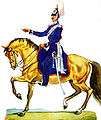
Second Lieutenant of Cavalry 1856
-

Cavalry 1878
-

Serbian army Cadets in 1861
-
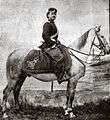
Serbian Cavalry officer 1865
-
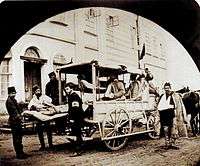
Serbian health care car during the Serbo-Turkish War (1876-1878)
-

Milan I of Serbia in uniform
-

Serbian army officers 1880
-

Serbian towed gun, soldiers practice, late 19th century
-
Serbian soldiers 1901.
-

Serbian Guard late 19th century
-

Infantry Regiment "King Petar"
Current
See also
References
Sources
- Bjelajac, Mile (2015). "Tradicija". O Vojsci. Vojska Srbije.
- Vojna granica i srpska vojska. Štamparija Drag. Gregorića. 1936.